
 |
Eager Space | Videos | All Video Text | Support | Community | About |
|---|



Pogo is a longitudinal - forward and backwards - vibration that occurs in rockets that use liquid fueled engines.
It was an issue with the Titan II missile, shown here in the Gemini V launch, and the Saturn V rocket, shown here in the Apollo 8 launch.
Pogo can range from a minor annoyance to a mission-ending problem.
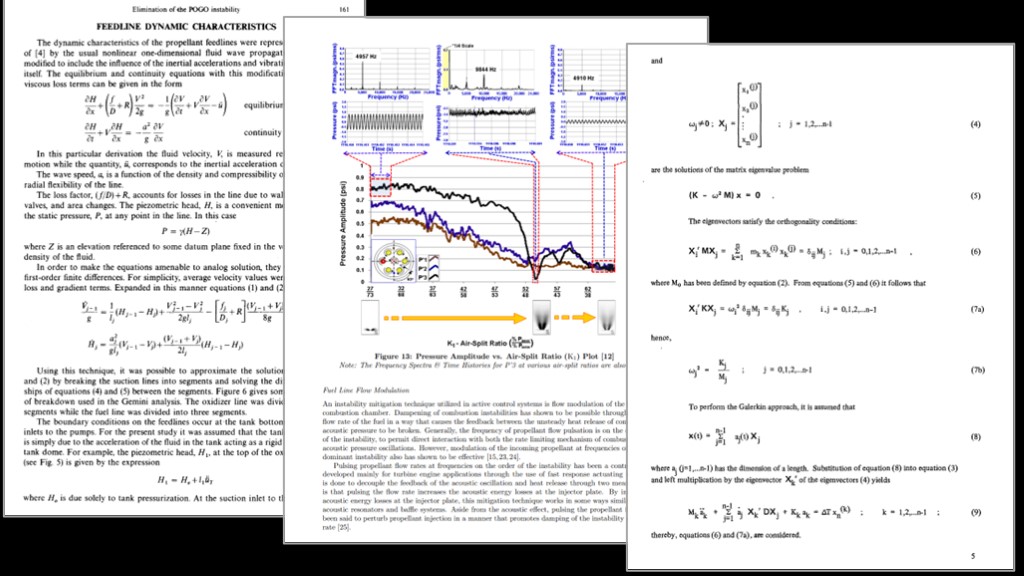
Pogo is a complex phenomena.
If you want to dig deeper, I recommend "NASA Experience with Pogo in Human Spaceflight Vehicles", which I have linked in the description of the video.
If you want more depth including all the math, I've linked to some other resources that should make you happy.
Add link:
https://ntrs.nasa.gov/api/citations/20080018689/downloads/20080018689.pdf
https://ntrs.nasa.gov/citations/19730007197
https://sci-hub.se/https://www.sciencedirect.com/science/article/pii/B9781483198217500144
https://ntrs.nasa.gov/citations/19710016604
https://www.researchgate.net/publication/268472794_Overview_of_Combustion_Instabilities_in_Liquid_Rocket_Engines_-_Coupling_Mechanisms_Control_Techniques
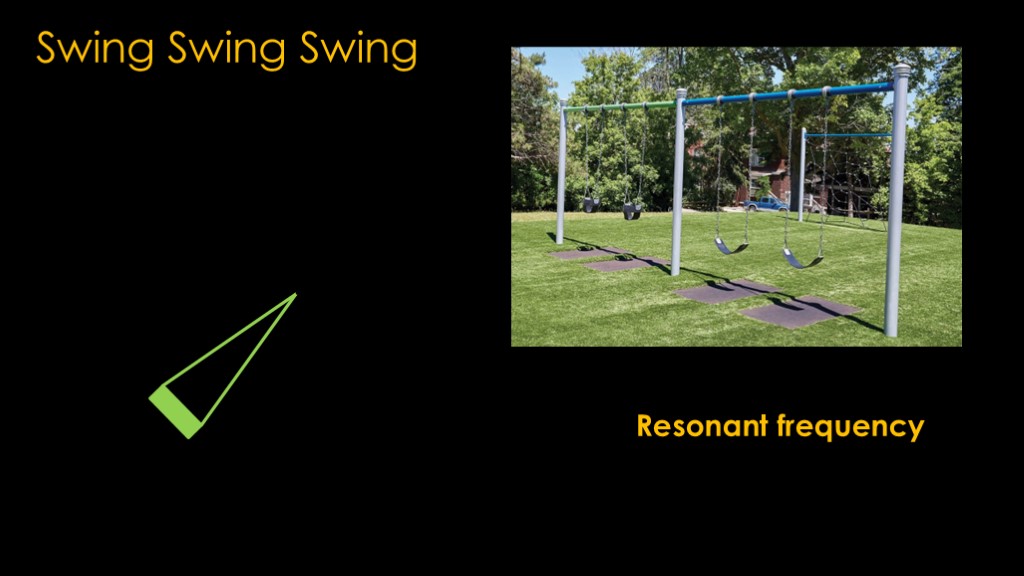
We're going to start with a very simple model that most of you should be familiar with, a common playground swing.
We know that to make a swing go higher, we need to push it at the right moment, ideally when it is just starting to go forward. Push it the wrong time - say when it's coming back - and it will swing lower, not higher.
The optimal frequency - the frequency at which pushing it produces the biggest effect - is known as the resonant frequency.
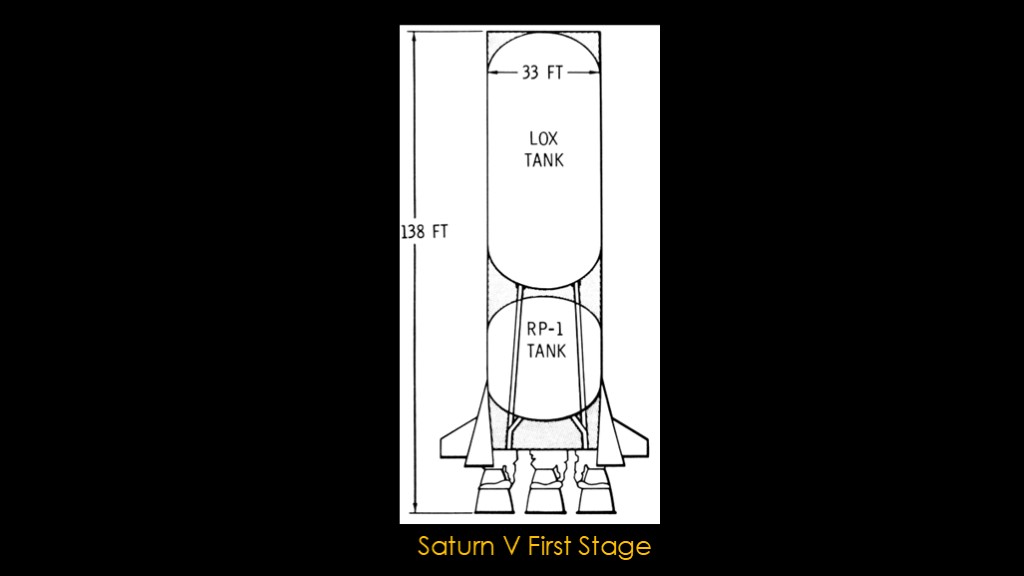
We're talking about liquid fueled rockets, and all liquid fueled rockets have propellant tanks, and they all have feed pipes at the bottom to convey the propellants to the engines. Here we see the first stage of a Saturn V, with a small RP-1 fuel tank at the bottom with short feed lines and a large liquid oxygen tank at the top with long fuel lines.
We'll be looking at the liquid oxygen tank in this example.

We know that if we have a tank filled with liquid, the pressure at the top of the tank is much lower than the pressure at the bottom of the tank.
If we look at a propellant tank, at the very top there will be no pressure, near the bottom of the tank there will be more pressure - I've arbitrary chosen 1 atmosphere - and then at the bottom of the feedline, there will be even more pressure, say, two atmospheres.
This pressure is from the gravity pushing down on the propellant, or 1 g of acceleration
If the rocket is accelerating upwards at 1 g, the total acceleration would be 2g, and that will double the pressure.
Or, to generalize, more acceleration in the rocket will lead to more pressure.
How would we get more acceleration? We would get it if the engine thrust increased.
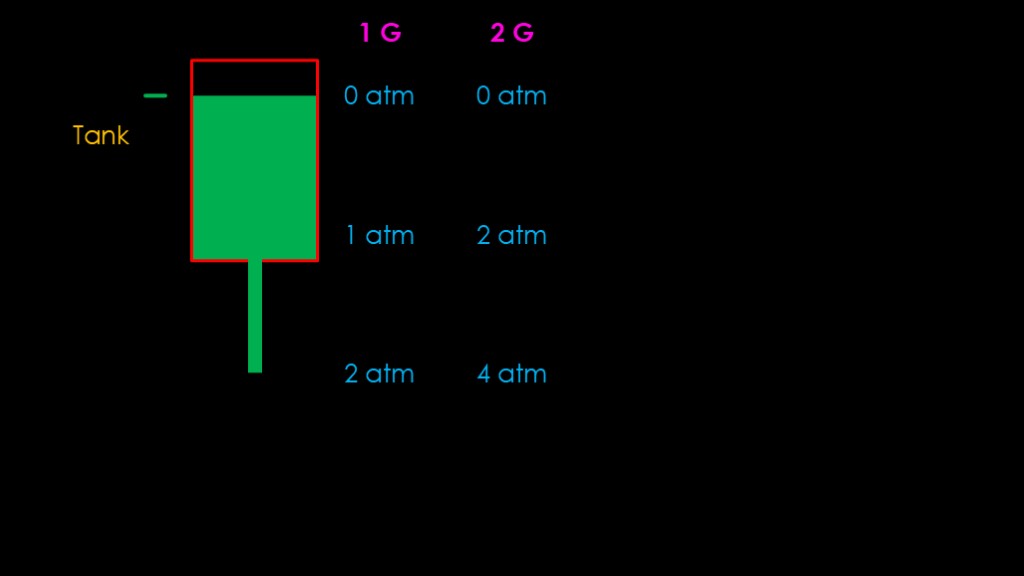
Let's assume there's a little increase in thrust, which produces a little increase of acceleration. That will produce an increase in pressure, but it won't happen instantly.
What we get is a pressure wave that starts at the top of the tank and travels towards the bottom. It will travel at the speed of sound in whatever liquid is in the tank. If it's liquid oxygen, it's about 1050 meters per second.
The important point is that there is a bit of a delay between the increased thrust of the engine and the increased pressure at the bottom of the feed line.
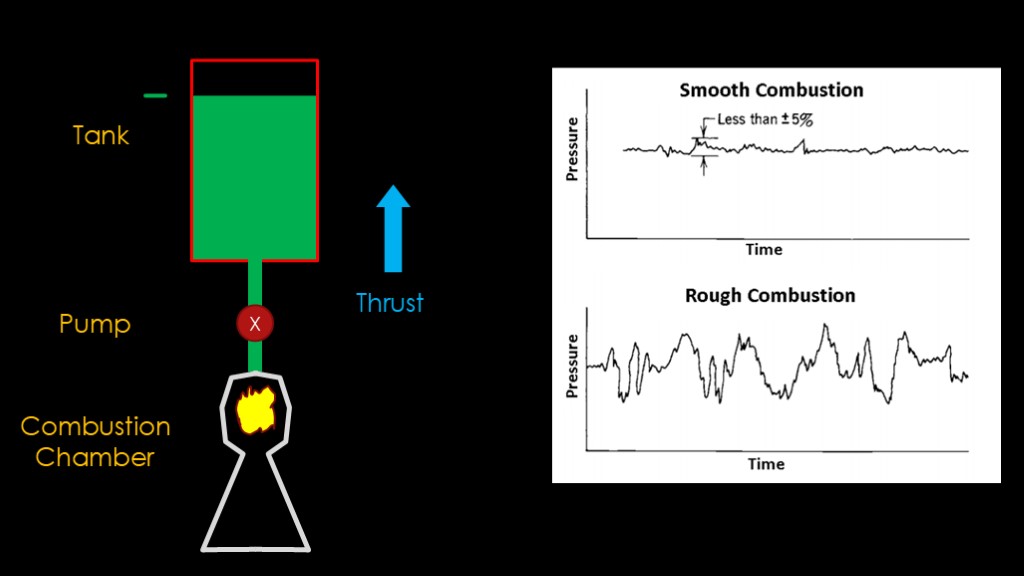
Now we'll add the rest of the rocket. There is a pump connected to the tank, and that is connected to the combustion chamber of the rocket. The engine is running, and that produces thrust that is pushing the rocket forward.
Rocket engines do not produce power that is totally smooth - there are variations - or instabilities - in the combustion. Some are smoother, some are rougher, but they all have pressure variations, and therefore they have thrust variations. The pressure spikes up and the thrust spikes up.
That leads to a pressure wave in the propellant that travels down to the combustion chamber, which enters the combustion chamber and causes a second pressure and thrust spike.
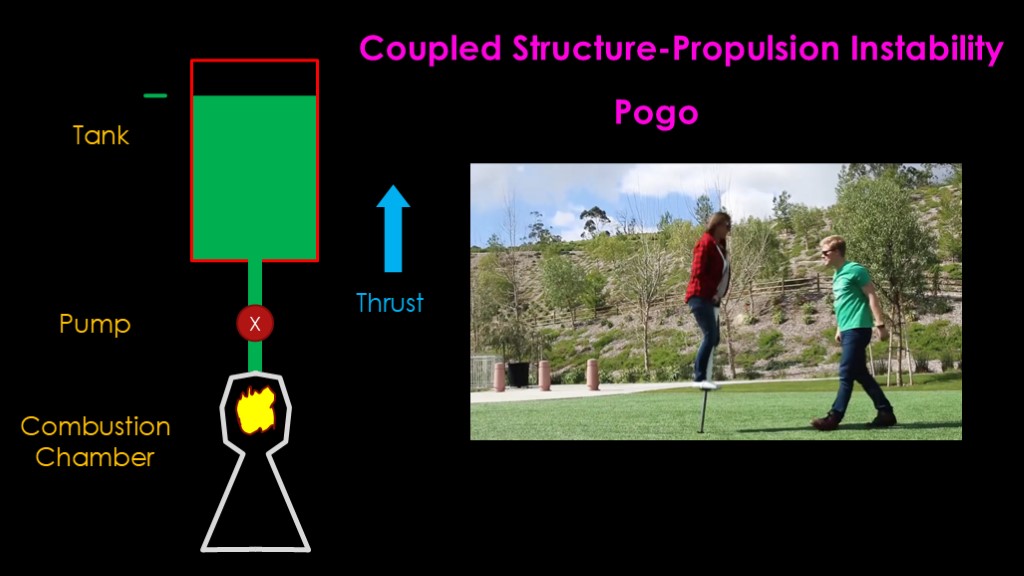
This situation is very much like the swing we looked at. If the pressure pulse arrives at just the right time - as the pressure is already going up - it's like the push on the swing that sends it higher. We end up with an oscillation that continues as long as the proper conditions persist.
This is formally known as "coupled structure-propulsion instability" - the structure of the rocket and the behavior of the engine are working together to produce a problem.
It's more commonly known as "Pogo", because the up and down thrust variations are like the motion of somebody on a pogo stick.
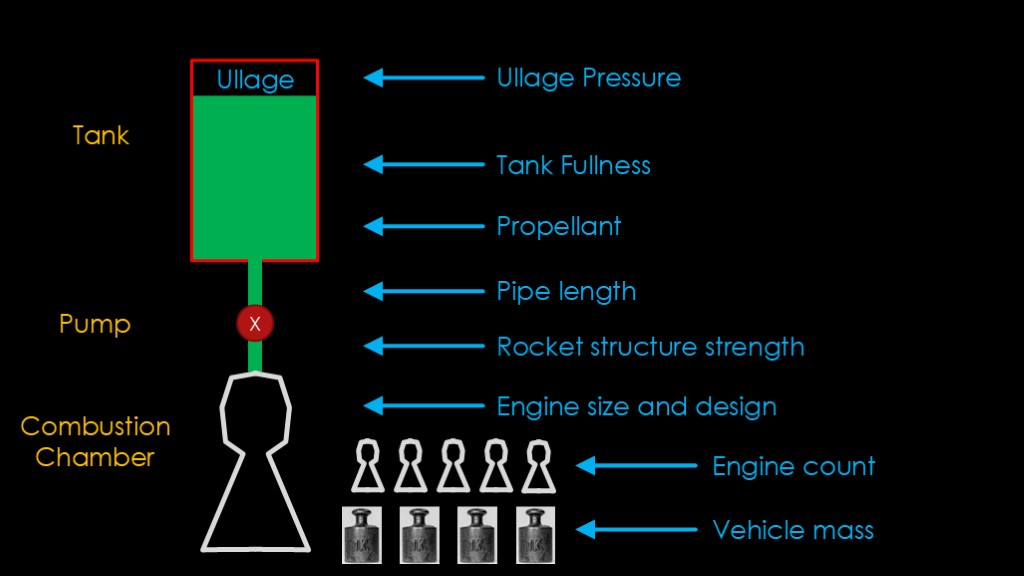
Pogo is affected by a number of different factors.
The pressure in the empty part of the tank, known as "ullage pressure" affects the pressure to the pump
Fuller tanks produce a stronger pressure wave.
Denser propellants produce stronger pressure waves.
Longer pipes produce stronger pressure waves
The rocket structure itself can flex and change the length of the pipe.
The size and design of the engine effects how smooth the combustion is and the effect of pressure waves on combustion pressure.
More engines will reduce the thrust variation due to random fluctuations in an individual engine
And finally, the vehicle mass matters. When a stage is full of fuel and heavy, a given amount of thrust variation produces a small acceleration variation. As the stage uses propellant and gets lighter, that same thrust variation produces a much greater variation in acceleration, and therefore a stronger pressure wave.
Let's look at an example.
https://www.researchgate.net/publication/268472794_Overview_of_Combustion_Instabilities_in_Liquid_Rocket_Engines_-_Coupling_Mechanisms_Control_Techniques/link/5a2f42920f7e9bfe81702dbc/download
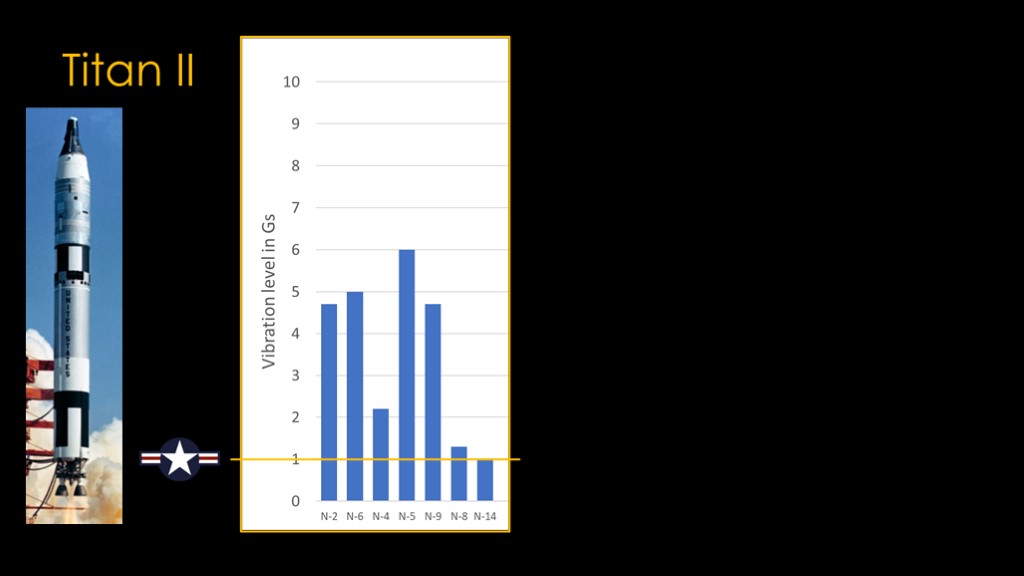
Titan II was initially developed as a missile by the air force.
This chart shows some of the vibration levels measured during early flights, and it has a Pogo problem - significantly exceeding the air force acceptance threshold of 1 g on many of the flights.
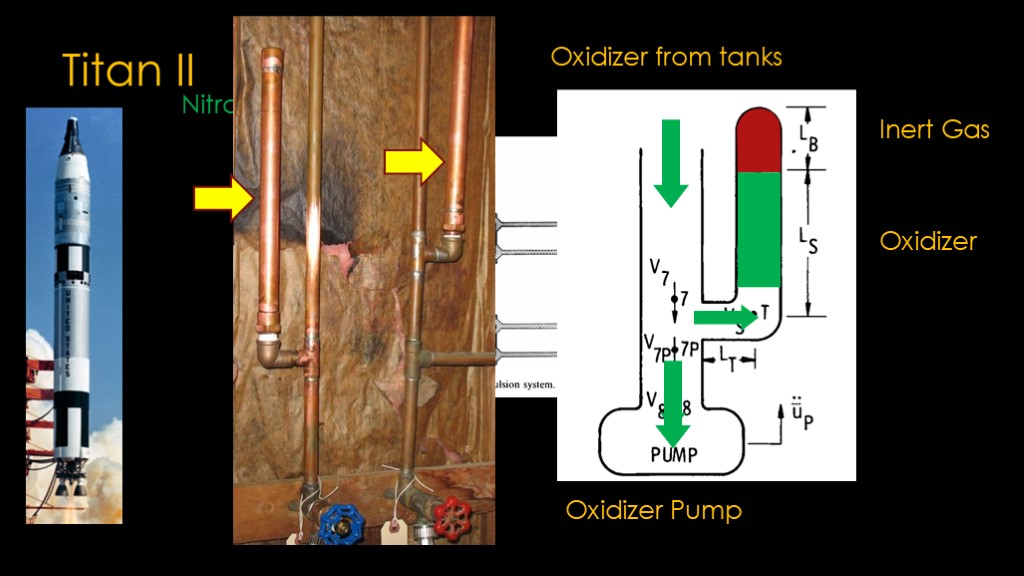
The Titan II used storable hypergolic propellants, with Nitrogen Tetroxide as the oxidizer and a stable hydrazine blend known as Aerozine 50 as the fuel. These propellants are relatively similar in density and therefore either could be the culprit.
Based on a mathematical model of the propellant system and the resonant frequency of the entire Titan II, engineers zeroed in on the oxidizer feed lines. What they needed was a way to reduce the pressure wave.
There is a similar problem in household water systems. If water is flowing through pipes and is shut off rapidly - say in a washing machine - the result is a big pressure spike called "water hammer" that can damage the pipes. The fix is to add air chambers on the pipes.
For the Titan II, they installed a standpipe near the oxidizer pump - a short piece of vertical pipe with a closed end. During fueling, the standpipe would be filled with oxidizer except for a small space filled with inert gas, nitrogen in this case.
When a pressure wave comes down the feedpipe, it normally went straight into the pump. With the standpipe on the side, some of the pressure wave was diverted into the standpipe where it compressed the inert gas.
This reduced the size of the pressure wave.

They flew with this fix, and it had a big impact, but not the way they had been hoping - the G oscillation went up to 9 Gs.
The NASA MSC Director remarked to his Manned Space Flight Management Council that he saw one hope: "the fact that the addition of the surge chamber affected the oscillation problem may indicate that the work is being done in the right place."
Pogo was not well understood in the early 1960s and the analysis tools available were quite primitive.
Further analysis pointed the finger at cavitation in the turbopumps. Cavitation occurs when the pressure exceeds the vapor pressure of the liquid, and bubbles form. These changed the frequencies in the calculations, and new calculations showed that it was the fuel feedlines that were more problematic.

The next series of flights flew without the oxidizer standpipe and replaced steel feedlines with aluminum. That produced this series of results, which was good enough for the air force.
But not quite low enough for NASA - their goal was ¼ G.
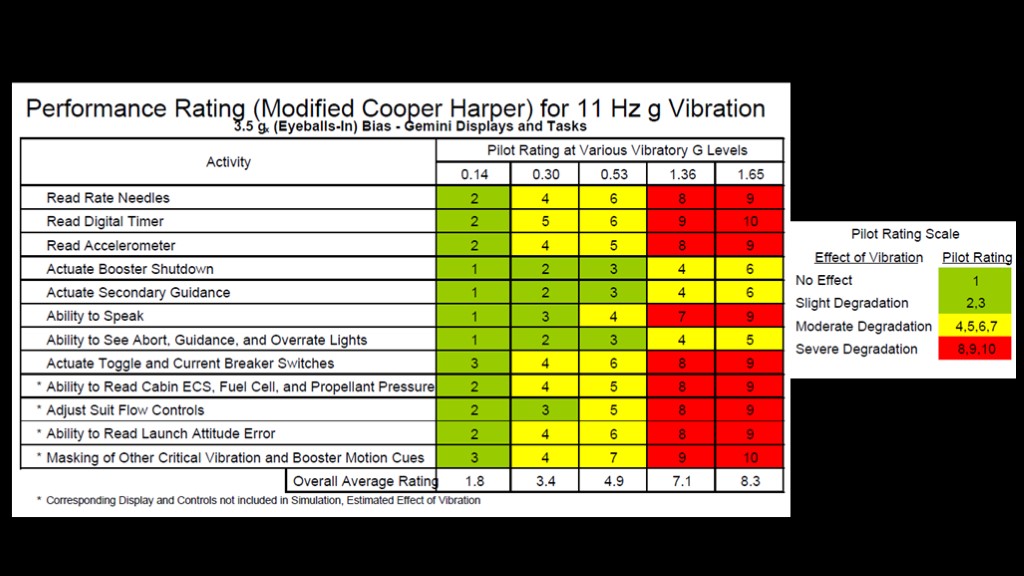
NASA had done considerable testing in the centrifuge to determine the effects of G loads on astronauts, and they had chosen the ¼ G threshold based on those tests.
More work needed to be done.
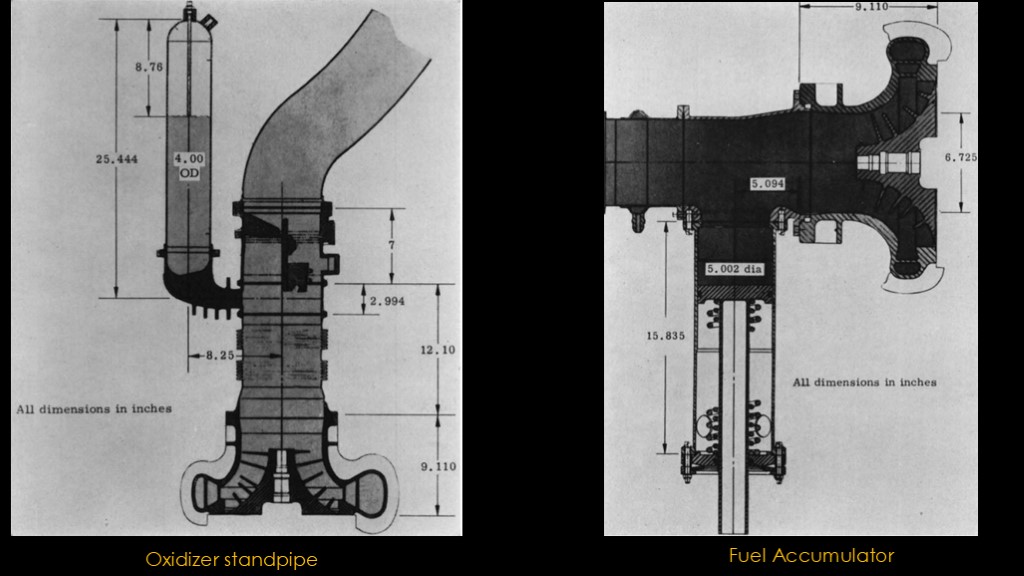
NASA made a few phone calls and called in some favors, and the air force agreed to fund further development.
They decided to install a fuel accumulator to reduce the pressure waves on the fuel feedlines and a redesigned oxidizer standpipe based on the updated analysis.
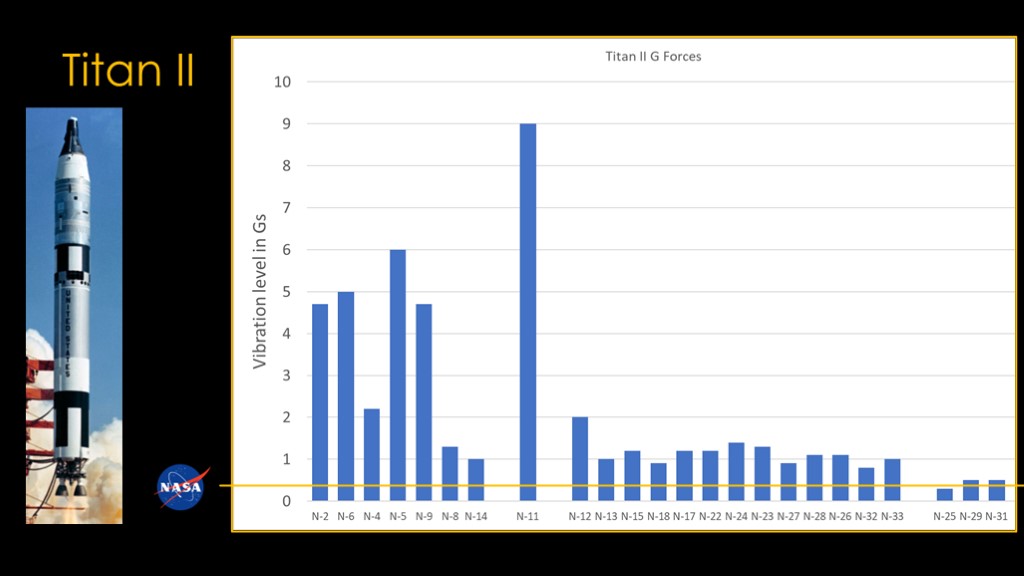
Tests with that new configuration validated the theory, with the lowest Titan II vibration levels seen, and good enough for NASA's requirements.
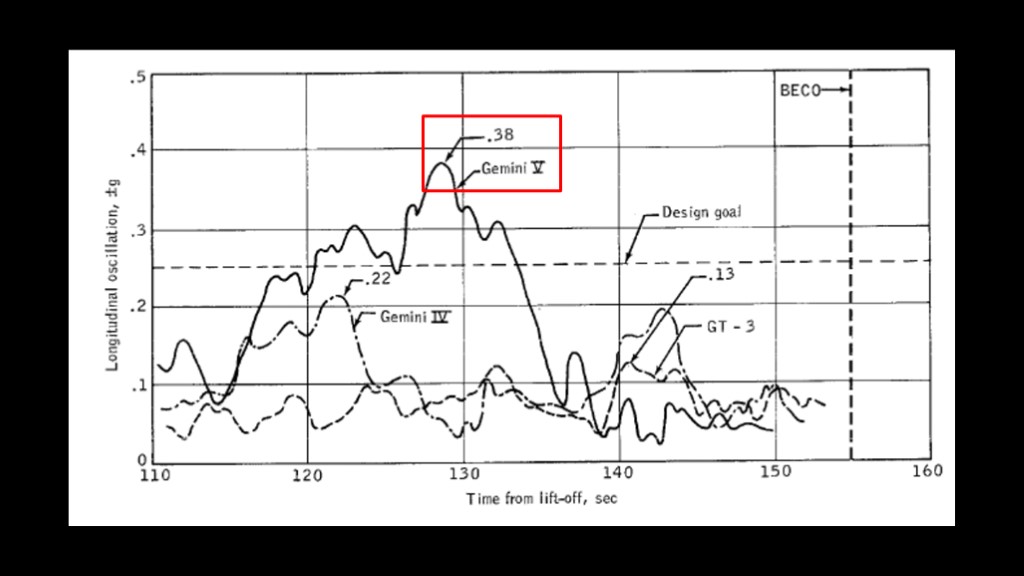
Performance during Gemini flights was mostly within the ¼ g specification, with Gemini V as one outlier.
Gemini V had a long hold before launch after the nitrogen gas was introduced into the oxidizer standpipe. The nitrogen readily dissolved in the nitrogen tetroxide oxidizer and most of the space at the top of the standpipe was instead filled with oxidizer.
This same effect happens in residential plumbing air chambers.

Onto Apollo...

On the second test flight of the Saturn V, there was significant Pogo during the first stage segment. This is a good illustration of how a vehicle may be stable during part of the flight but as vehicle mass goes down, pogo may show up.
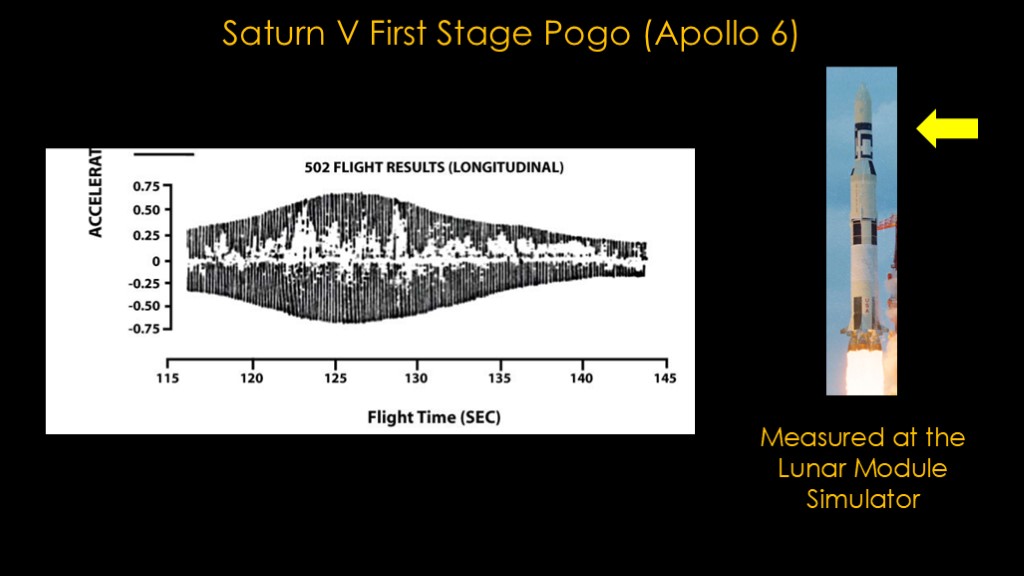
This is a close up view of the pogo portion of that flight . At the start of Pogo, the acceleration is changing between roughly 2.5 and 3 Gs, and at the worst, it's between roughly 2.5 and 3.5 Gs.
That's far above the NASA requirement for Gemini, and it was measured all the way at the lunar module simulator, so it's representative of what the astronauts would feel on launch.
Perplexingly, the first launch of the Saturn V did not have this issue, and NASA and the contractors had done considerable work to ensure the Saturn V would be Pogo free.
Deeper analysis using more data showed that the first stage was marginally stable; on the first launch, the conditions were just on the stable side, and on the second launch, on the unstable side.
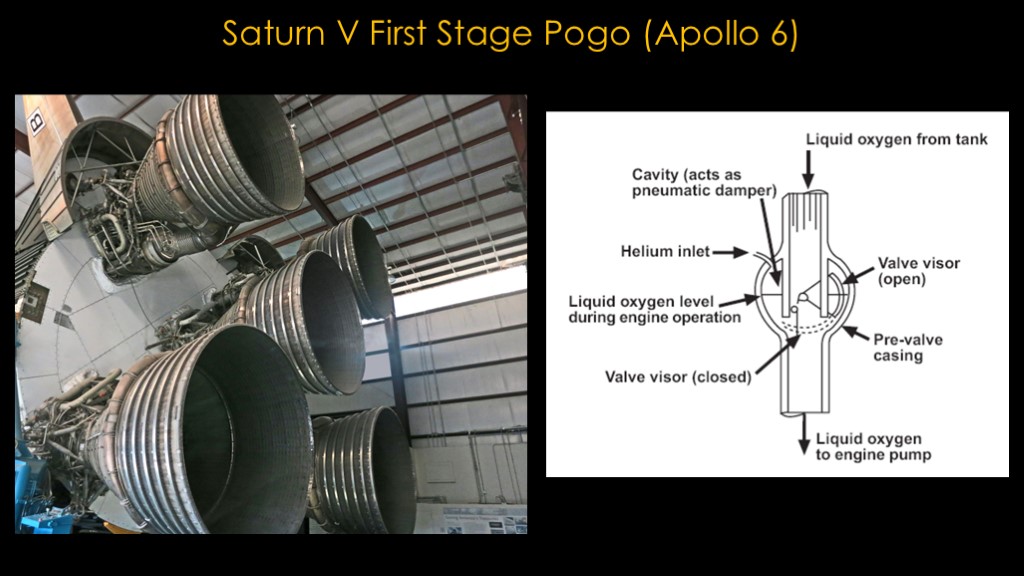
The problem was compounded by the huge F-1 engines used on the Saturn V; they used very big combustion chambers and were inherently not as stable as smaller engines. This is one of the reasons that nobody builds engines this big.
NASA addressed the pogo problem with an accumulator on the liquid oxygen line; there was a big cavity pressurized with helium, and that served to damp down the pressure wave, and it fixed the first stage pogo.
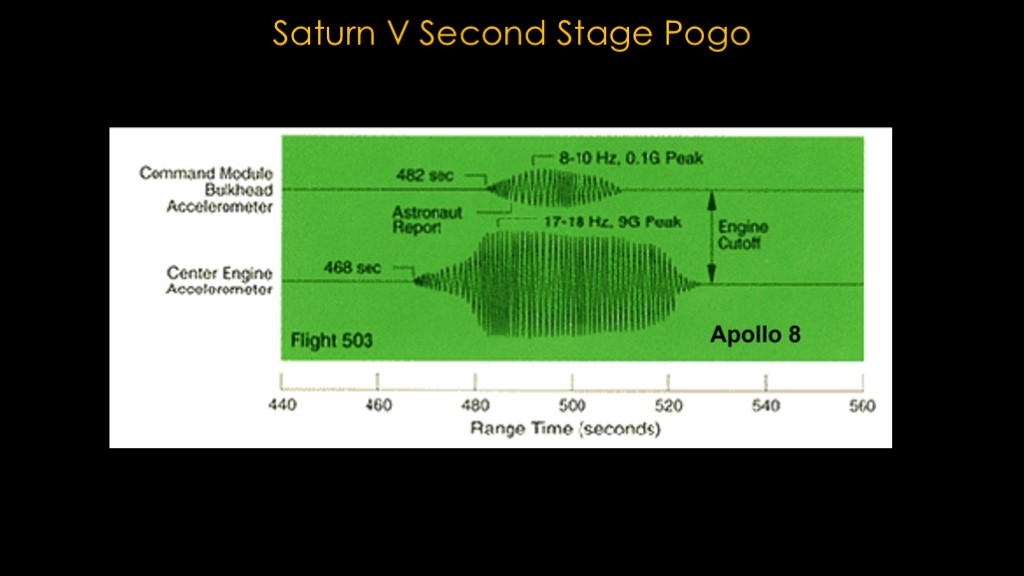
Interestingly, the crewed flight of Apollo 8 exhibited an instance of Pogo on the second stage with a very different cause.
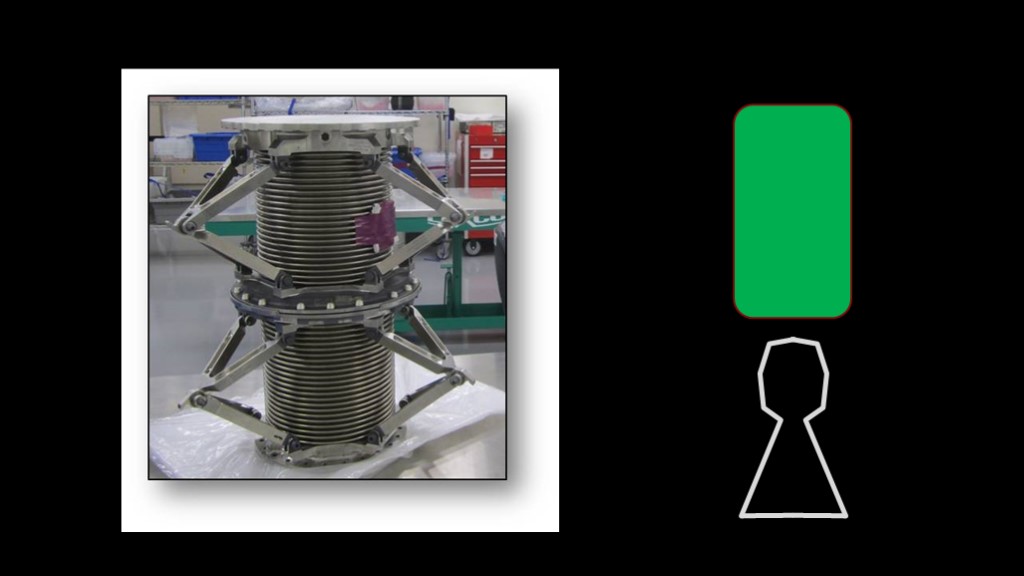
Most engines need to be able to rotate - or gimbal - to control the path of the rocket. That presents a problem - the engine needs to move without breaking the propellant lines that are attached to the stage.
That is accomplished with a flexible duct with bellows that can extend, contract, and bend, and that accommodates the movement.

The center J-2 engine on the Saturn V second stage was mounted to a cross structure that was attached to the stage at the outer edges but not in the middle. This design set the stage for a problem.

Here we have the engine mounted to the cross beam supported by the tank, with a flexible bellows in the middle. There would actually be two bellows, one for each propellant.
Start the engine...

and the thrust of the engine bends the crossbar upwards a bit, and that shortens the bellows. The reduced volume of the bellows increases the pressure of the propellants, that results in more thrust in the engine

And that bends things up a bit more.
What happens next depends on a number of factors. Early in the flight of the stage, the engine just finds a stable spot and stays there.
But as the fuel is burned off, conditions change.

Let's say we get a little random spike in thrust that bends the beam up even more. This beam really wants to unbend, so when the increased thrust goes away, it does that...

That lengthens the bellows, the engine pressure drops, and the thrust drops. We have now set up a pattern - each time the thrust drops, the bellows lengthen, and that results in more thrust drop...
This continues as the beam unbends and the thrust keeps dropping, perhaps with the beam bending in the opposite direction.

We are now at the bottom position. The bellows have refilled, the engine is producing normal thrust, and the beam wants to bend forward again. The cycle repeats.
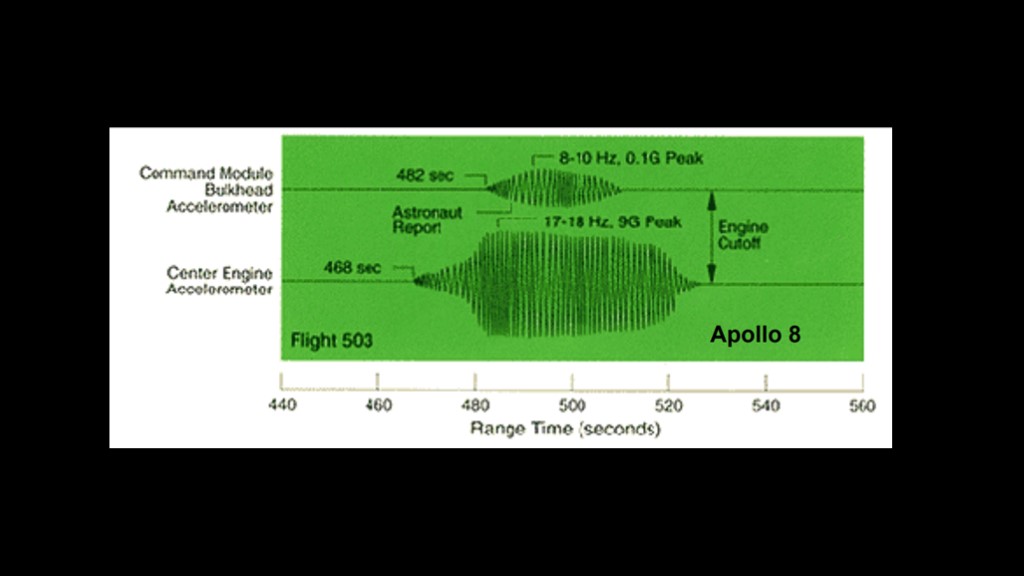
This data is from apollo 8.
The top trace shows the effect on the Apollo command module of the pogo. It was at 8-10 hertz, so think of watching a movie in a theater with a very good sound system that you feel. That's what the astronauts felt, but it was only about 1/10th of a g, so it was noticeable but not significant.
But remember that the engine was flexing the support beams up and down. The bottom trace shows the movement of the engine, and it was at 9 gs, which was getting close to the structural limits at around 15 gs.

Here's a chart showing the acceleration of the center engine during 4 Apollo flights - 9, 10, 12, and 13. For the first 3, it was fine - within structural limits and therefore deemed not to be a flight hazard.
On Apollo 13 at about 160 seconds, the center engine experienced an acceleration of 34 gs. The top of this chart is only 12 gs, so it's really an unprecedented level of acceleration.
The reduction in pressure when the engine flexed down was so significant that the engine thought it had run out of propellant and shut itself down, and that saved the vehicle from structural failure on the next cycle.
https://ntrs.nasa.gov/citations/19860001748
https://ntrs.nasa.gov/api/citations/20080018689/downloads/20080018689.pdf
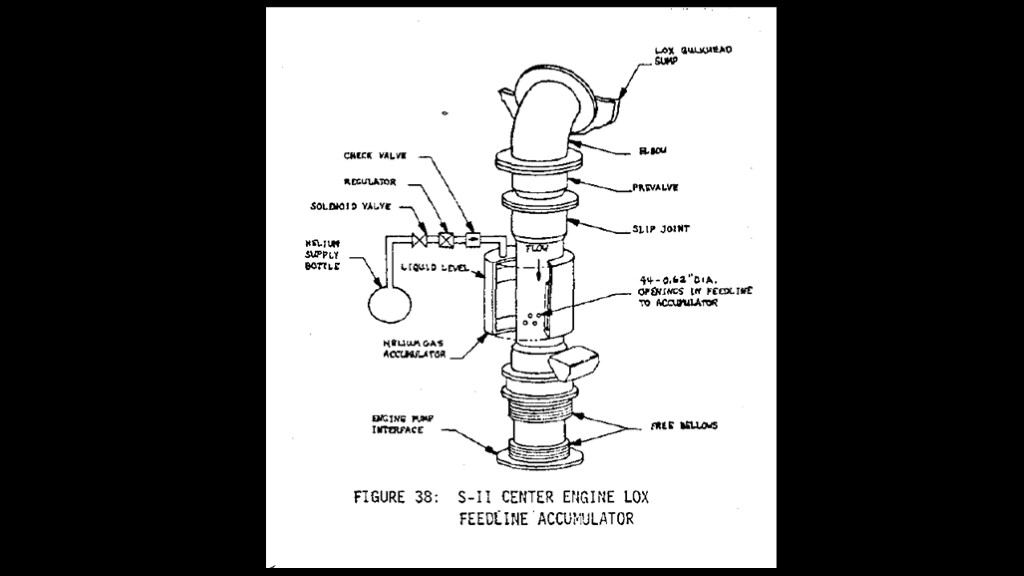
The fix was pretty simple - add an accumulator as was done on the first stage - but there was very little room. NASA ended up taking an existing part of the piping, drilling holes in it, and encasing it in a drum that was pressurized with helium. That was enough to fix the problem.

Onto the space shuttle
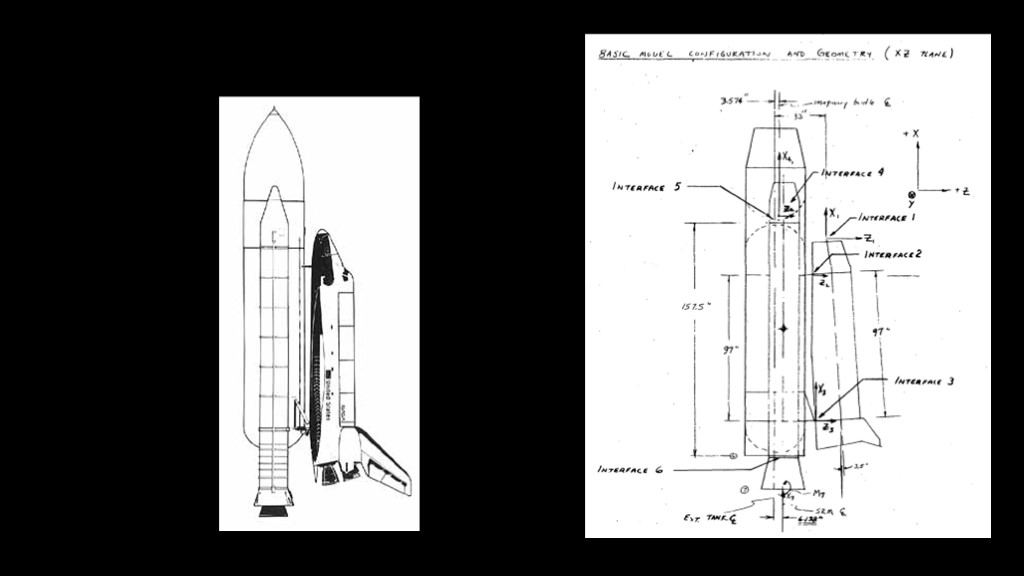
The space shuttle presented NASA with a significant problem with respect to pogo.
The traditional approach was to analyze the rocket structurally, but the shuttle is a very strange launcher. Not only does it have 4 separate parts - the orbiter, two boosters, and a huge external tank - both the payload mass and location differed from mission to mission. NASA created models but it made the analysis very difficult.
They also planned on flying crew on the first mission and losing the crew or the orbiter would be very bad.
They therefore decided to take a more proactive approach. Instead of the "fly and fix" approach used on Gemini and Apollo, they would do up-front analysis, design a motor that would be as "Pogo proof" as possible, and validate it with testing that that subjected the engine to pressure pulses.
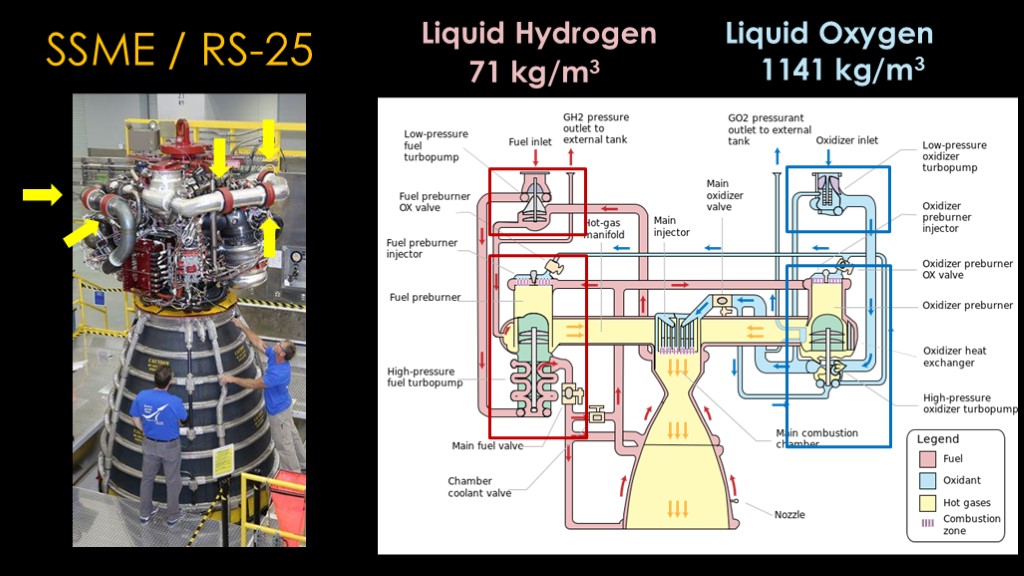
The engine used in the shuttle is the space shuttle main engine, or RS-25. This engine uses liquid hydrogen as a fuel and liquid oxygen as the oxidizer. These fuels are very different in density, with liquid oxygen 16 times denser than liquid hydrogen. That means that any pressure waves in the liquid hydrogen feed will be much smaller, and it turns out that you can just ignore the hydrogen side.
Like many engines, the RS-25 has high pressure turbopumps to feed the fuel and oxidizer into the combustion chamber, but under testing, they found that these pumps would cavitate because of insufficient input pressure, which reduces pump efficiency and can damage the pump.
To fix the problem, they added two low pressure turbopumps to take the propellant from the tanks and raise its pressure high enough so the high pressure pumps would not cavitate. This is one reason the RS-25 is so complex and so expensive; it has the systems of a normal rocket engine with two extra turbopumps grafted to the outside.
The low pressure turbopumps are fixed rather than attached to gimbals, so any pipes or ducts between them are connected with flexible bellows. The ones shown here connect the outputs of the low pressure turbopumps to the inputs of the high pressure turbopumps. These are just some of the big ones; there are flexible connections on every pipe that goes between the low pressure side and the high pressure side.

The initial plan was to put the pogo suppression in the traditional place, between the oxidizer feedlines and the pumps, but analysis showed that there were still scenarios where pogo might show up in the plumbing between the two oxidizer turbopumps, so the pogo suppression is placed at the input to the high pressure oxidizer turbopump.

The system is fairly complex. The accumulator is pre-charged with helium at a specific pressure before launch but after launch it is switched over to gaseous oxygen.
Note the location of the accumulator in relation to the flexible bellows that connect the low pressure and high pressure turbopumps. NASA found that for the system to work as desired, the accumulator needed to be on the high pressure side of the bellows. This is likely due to possible volume changes in the bellows part of the line causing issues, similar to the ones seen on the J-2 engine on the Saturn V.
http://large.stanford.edu/courses/2011/ph240/nguyen1/docs/SSME_PRESENTATION.pdf
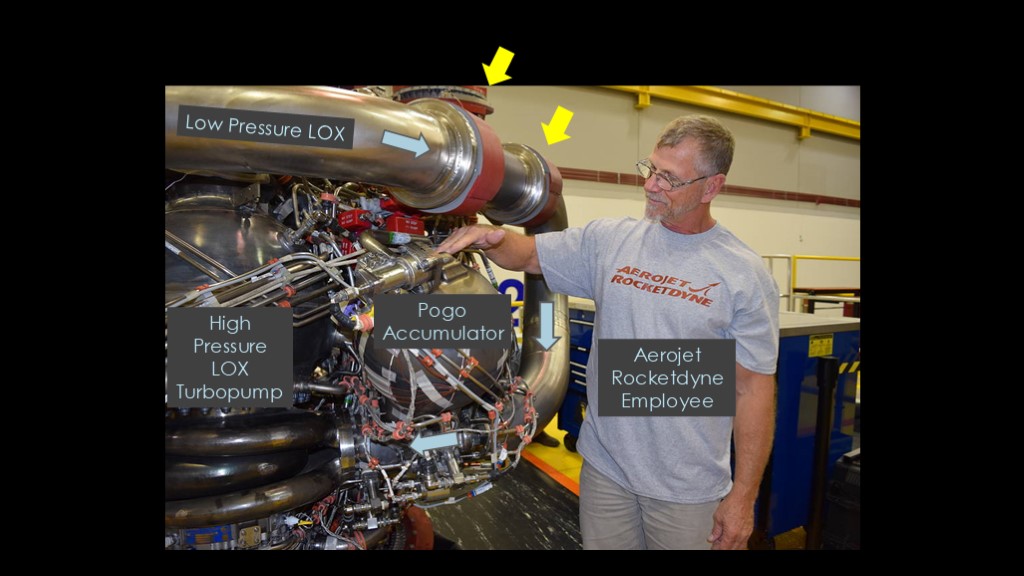
Here we have a wonderful picture of the system.
At the top we have the Low Pressure liquid oxygen coming from the low pressure turbopump. It goes through two bellows that allow the engine to gimbal, heads down, and turns to head towards the inlet of the high pressure LOX turbopump.
Directly before the input to the turbopump is the pogo accumulator, as indicated by a helpful Aeroject Rocketdyne employee. Note that the accumulator is as close as possible to the high pressure turbopump.
With this system, shuttle did not have pogo issues.
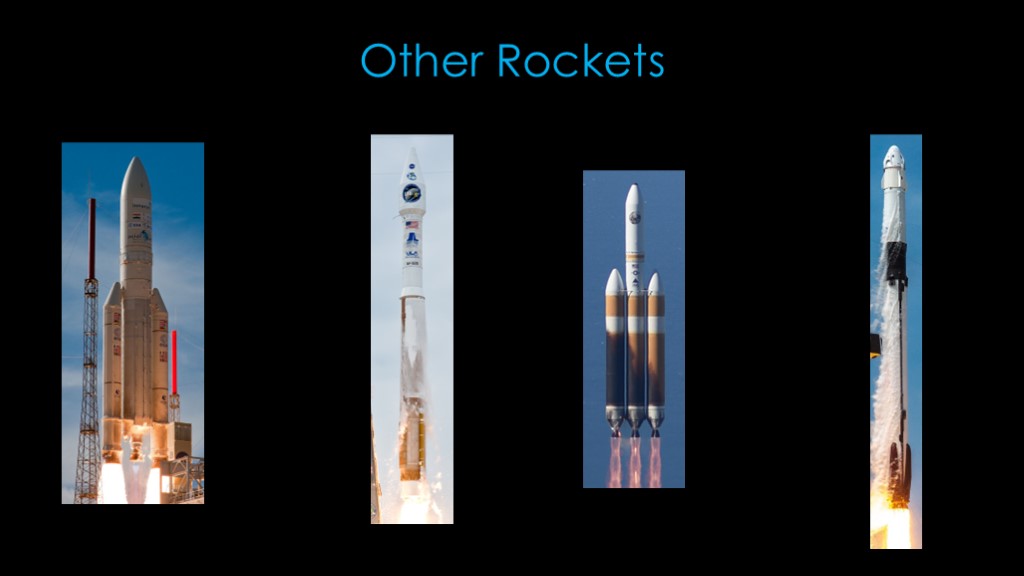
What about other rockets? There aren't a lot of details available, other than mentions that Ariane, Atlas V, Delta IV, and Falcon 9 all use anti-pogo measures.
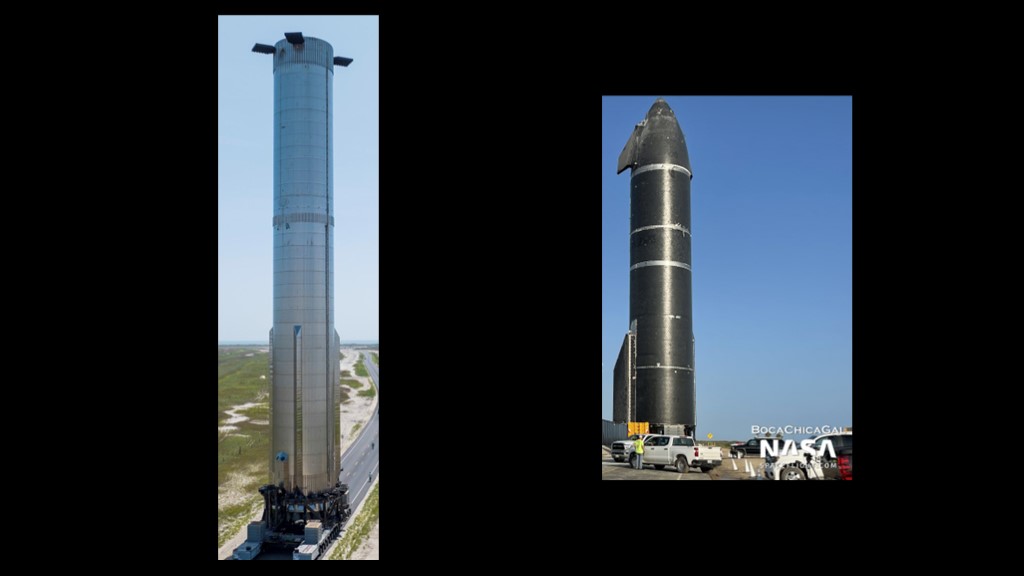
What about starship and super-heavy?
I haven't seen any evidence one way or the other.
Super heavy has the advantage of having a *lot* of engines - so many that instabilities might not be a problem on ascent, though it will use a small number of engines to land. Starship is likely in a similar situation.
My guess is that SpaceX is probably using pogo control techniques - either traditional ones or active controls.

If you enjoyed this video, please listen to Just Another Day by Oingo Boingo - or buy yourself a slinky.
Add link to: https://www.youtube.com/watch?v=FFU_5Ng-4DM